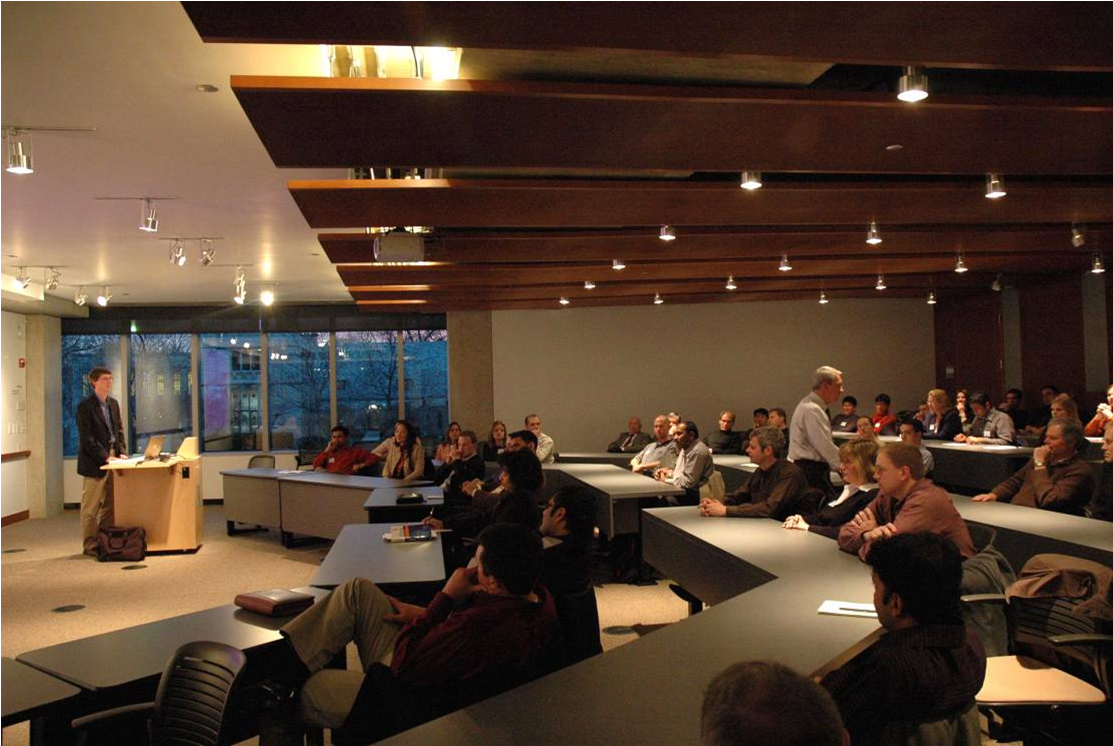
When I look at plans for Professional Development, I think we are missing the point. We make it all about the individual shaping his or her future. There should be more to it if one takes the notion, professional development should involve the people who have a say in a person’s career.
Organizations say, maybe even believe in professional development, but there is an important missing link. When it comes down to it, how many actually make the most use of it. I began this article looking again at the differences between training and education, or trainers and teachers. In A Look at the Education vs Experience Debate and in an earlier post, What’s the Difference Between Training and Teaching, I made a few comparisons. This time, I thought it might be interesting to comment on what some consider the end-result of training: professional development.
To some organizations, professional development means a training day of best practices. This isn’t professional development; this is only a day of opportunity. Some organizations send employees to regional and national conferences. However, there are conferences held by similar and not so similar organizations that valuable information and best practices in a different context. We have to ask: are the people sent these conferences, the ones who can benefit the most? Or, even those who will aim for learn what’s new and innovative in their field. Most conferences are intended to be information sharing; however, most attendees are more likely to be sharing drinks. Ironically, it is during these moments of relaxed opportunity the best information to aid in one’s quest for professional development occurs. Still, that is not professional development — but it’s a start.
Professional development includes so much more. Interestingly enough, the social aspects, character modeling and professional information comparisons from a single conference may be more valuable than a single, specific knowledge-based training day. And that’s really not much at all in the total scheme.
Professional development refers to the acquisition of skills and knowledge used for personal development and for career advancement. Generally, professional development would include all types of learning opportunities some facilitated and some not. It should start with specific training, college and university education as well as conferences and never end. Along the way, continuous learning should provide other opportunities and practice specific to an employee’s position and career goals.
Many organizations fall short. They may have a director of professional development, who in most cases is a glorified training manager. That’s not always the case, of course. There are professional development directors who understand the concept, but many other who do not. It could be they have the definition wrong.
 At its core, professional development with an organization should begin with a plan for long term use of an employee. At interviews and during the orientation references are made about employee growth, but, for the most part, the employee is left alone after that to survive and strive or not deliver and not survive. The individual employee, unless mentored by someone with influence, is left to his or her devices when it comes to professional development. The valuable employees are those who seek out additional opportunities to learn, continuously learning. Ironically, and it shouldn’t be, these same employees ask for raises and promotions, which may annoy their superiors.
At its core, professional development with an organization should begin with a plan for long term use of an employee. At interviews and during the orientation references are made about employee growth, but, for the most part, the employee is left alone after that to survive and strive or not deliver and not survive. The individual employee, unless mentored by someone with influence, is left to his or her devices when it comes to professional development. The valuable employees are those who seek out additional opportunities to learn, continuously learning. Ironically, and it shouldn’t be, these same employees ask for raises and promotions, which may annoy their superiors.
In an environment where professional development is practiced, the process is collaborative and intensive. Professional development should include a career manager who ensures employees are right for their jobs, and works to keep them in jobs that, not only make them successful but the organization as well. That is not to say there should not be an evaluative stage, but by incorporating career management, we assure someone who is not doing well flounder, but can thrive in another position.
In larger companies, this is easy to do. In smaller companies or organizations the same attitude toward professional development can be extended to the employee by modifying his or her position to include a different, yet positive skill set. If that doesn’t work, the employer should assist the employee in finding a more suitable position rather than him or her “kick to the curb;” asserting that this employee–who they hired–is now a nuisance, guilty of negatively impacting their mission. As a part of professional development, employers should offer support, and not grudgingly. Employer and employee responsibilities go both ways. At one time, providing an employee security and career develop was every corporation, company and organization’s mission.
In this current economy, it was the first employee support to go, followed quickly with practices of limiting hours, making employees part-time so benefits were not required. With failure or disappointing results, newer, less experienced employees are the ones to go–with the hope being that this will change the financial outlook.
Then, again there are employees who lose it, who don’t fit in anywhere anymore. Too much damage is done.
Perhaps it could have been prevented by nurturing rather than coercing production based on potential termination or demotion. “If this doesn’t happen, you’re fired.” And said nicely, “So, if you fail to deliver…” with threat hanging there. It isn’t always a competence or performance failure, but sometimes–often times, a personality factor.
Not everyone fits with everyone in the organization. In room filled with people who do the same thing, there are only a few true connections; the rest are tolerated. Unless, one or two cannot be tolerated. Now, we get into leadership and management issues, which if you think about them, are intricately linked to professional development.
 The process of professional development is mistakenly called training and vice versa. We train for a career by learning a trade or receiving an education. After that, any type of “training” is immediately included in the professional “portfolio,” as if presentations on diversity and sexual harassment have to do with an individual’s career growth. Not that those items–usual presentations or simple computer orientations–don’t have value, but they have more to do with character. Certainly, not paying attention in those areas could result in termination of one’s career. Still, by definition, it is not part of professional development, nor are they really training. If anything, they seek to affect one’s moral character.
The process of professional development is mistakenly called training and vice versa. We train for a career by learning a trade or receiving an education. After that, any type of “training” is immediately included in the professional “portfolio,” as if presentations on diversity and sexual harassment have to do with an individual’s career growth. Not that those items–usual presentations or simple computer orientations–don’t have value, but they have more to do with character. Certainly, not paying attention in those areas could result in termination of one’s career. Still, by definition, it is not part of professional development, nor are they really training. If anything, they seek to affect one’s moral character.
People may be trained to do a specific job, or perform a job that requires a very prescriptive skill, i.e., a surgeon or architect. Attorneys learn about the law or more specifically; however, although they were educated in litigation techniques, they will not be considered trained until they have litigation experience. My preference for a surgeon is not one who has read about techniques in a book, but has practiced them. That could be said about many professions. And, here we are back with professional development, requiring training to be an element in career progression.
Continuing education or training is but one of the many ways to pursue professional development. These ways include simple lesson study (a specific training like leadership, supervision, management, analysis… Mentoring is a great way to incorporated and ensure proper employee development, as is individual coaching and consultation. As an Executive Coach, my job was to offer assistance, usually to middle management, assistance in speech preparation and delivery. Interestingly enough, my clientele were confidential. My clients did not want their company to know they had a coach. So, my business grew by word of mouth.
Rather than a training day, the organizational attitude should be about helping individuals learn and grow within as well as outside the organization. An employee who feels his or her worth is a valuable employee that gives more all the time, knowing the reward is always there. It doesn’t have to be compensatory unless he or she measures his or her worth by that compensation. However, that does take away from self-satisfaction. Had the corporations, companies, or organizations an enlightened view of professional development (and conveyed that to employees) my clients wouldn’t have felt the need for confidentiality. Naturally, they paid for professional development out of their own pockets. I’d say that’s an employee to develop and keep an eye on his or her career.
By having an attitude of continually exploring and learning new aspects of our profession, we, indeed, become professional. At various times, I was a spokesperson, then a teacher and finally, a trainer and speaking coach. Today, I teach and train. I’m constantly comparing the two words on my training and development blog. One blog in particular is the one garnering the most hits. Guess which one that is. It’s on the difference between teaching and training.
Professional development, it turns out, is misunderstood by many. I’m not saying I got it right or even say it better than others, but professional development involves training and teaching/education and is not as interchangeable as one may think. And, the subject is complex; I have only grazed the surface.
Finally, while professional development is thought to be different and sometimes the same, it doesn’t need comparison. Employers, employees and the economy changes over time. Sometimes we forget original intentions in favor of profit margins. Some might say we’ve forgotten the very people we hire to make our company or organization what it is today. We changed the definition when it didn’t suit our pocketbook or actions. Many English words have interchangeable definitions and usage; however, there are times in which we should look back for the original meaning and pursue those intentions. Professional development needs to be new again, and used accordingly.
The above is reposted from my Training and Development Blog for the Free Management Library.





This is a valuable topic but the article has so many errors It is difficult to read.
Brian, you are welcome to write a response that speaks to those errors. If I had an opportunity, I would edit out the first two paragraphs. In adapting my commentary to GovLoop, I think the first two paragraphs as stated here are confusing. Saying that, I am not aligned with any business organization. My views are based on my observation after working in training in the Federal government and the private sector with key executives for over 30 years. Organizations have the best intentions, but their attempts do not affect professional development on all levels, and rarely are these attempts flexible enough to include the whole person in the equation. For most, it is up to the employee to figure out their own career–except for those at the higher level where there may be a detailed plan the employee has had a say in. There’s certainly a contract. I guess your one-line response says it all–without any embellishment. I’m sure you see things differently. I don’t know it all and I state that in my article. I say early on that I am writing commentary. I would welcome someone highly experienced in professional development to share what he or she knows, taking into account the workers who tread water waiting for management’s promise to help them grow.
Relax. All he’s saying is that the article was posted before it was adequately proofread.
Thanks, Jan. Perhaps I over-reacted. My apologies. These days my fingers leave out important words, or add them. And, my eyes don’t catch them as quickly as before. Unfortunately this isn’t all I write about. Busy writing-life in retirement. It would be nice to go into GovLoop blogs and edit. I can do that on the originating blog site.
Hi Jack – we are working on a fix that will let you edit blog posts after you’ve posted them. Stay tuned – and thank you for your contributions to GovLoop!
I shouldn’t suppose I can speak for Brian, but I believe the ‘errors’ he’s referring to are grammatical and/or spelling errors, and not errors in observation. A simple spell-check would probably have taken care of most of the problems. Additionally, if you are one who ‘practices what he preaches’ you might try a little flexibilty of your own in considering the intent of comments. Smooth your feathers sir, and re-read the article…what we’re commenting on will become readily apparent.
The notion of “professional development” is, perhaps, predicated on a social contract between employee and employer that may not exist anymore, or for much longer. Granted, that inattentiveness to PD may well expedite an employee’s departure. But even so, what guarantee does the employer have that the employee has any intention to remain within the organization, and not bolt the moment a better-compensated opportunity crops up? Conversely, what guarantee does the employee have that the employer will not find a reason to “restructure”, and either cut staff, or reassign them to less palatable, appropriate, or meaningful work?
I will offer up another idea for consideration. In our Canadian federal employee survey (functional equivalent of the FEVS), we used to ask employees about their perceived support for career development – both from their immediate supervisor, and from their organization. We also asked them how many supervisors they had had during the previous 3 years. Interestingly, as number of supervisors reported went up, perceived support for career development went down, as did things like encouragement to be innovative.
I suppose there are many ways to interpret this, including consideration of other factors not asked about or examined. I elected to interpret it as follows. If I am a new supervisor/manager, I hit the ground running. I keep my staff on short tethers because I don’t yet know whose judgment to trust or not trust. Moreover, I don’t know who to invest in, how to invest in them, or why. That WILL come, eventually, but as “new guy”, I don’t know enough. Stated differently, the longer I work with my subordinates, the better-equipped I am to grasp the rationale and form of developing them and letting them stretch.
So the fly in the ointment here is turnover at the supervisory/managerial level. Which presents us with a conundrum, because we see PD as also including development of leaders within the organization as paramount, and moving them around as important in *their* development. (As always, I refer people to “The Talent Myth”, Malcolm Gladwell’s classic essay on the HR side of the downfall of Enron). But it is this very mobility of the management cadre that tends to impede professional development of other staff.
In my own case, I have more expertise in my job than my supervisor does. Helluva nice guy, but I’m at asymptote. Budgets have been all but eliminated for conference attendance (I doubt whether I shall ever attend any more the rest of my life), and the best he can offer me is quickie, overpriced 1-2 day “courses” on software training, or workshops taught by folks with less experience in the subject matter than myself. In short, there is nothing to offer me for my development as a *professional*. As a newbie who needs “training”, plenty, but as a professional who wishes to learn, nothing.
And maybe that speaks to the matter of turnover at senior HRM levels. If THEY haven’t been in the saddle for very long, how do they know what the organization needs to provide for its own long-term viability? Which brings us back to your question about what’s missing in PD. And I think what we likely agree on is that what is all too often missing is a *plan*. Not “services” or “opportunities”, but a plan, guided by a notion of what the organization, as a living, breathing entity with a mission, needs.
Excellent post Mark Hammer! Interestingly enough, I recently read the corporate profile of Netflix’s employee development/talent retention program and find their “non-plan” open approach to be refreshingly simple and straightforward. Perhaps one of the recurring issues with most large corporations and government offices, is they don’t know how to plan, (how to keep it simple), how to execute the plan, (because they’ve over-complicated the process)…sometimes by NOT clarifying the plan in the first place, thereby allowing for painfully subjective interpretations, and most certainly, as you so eloquently stated, they don’t have a plan for those already ‘developed’ beyond the basics. Here in the US Federal Gov’t most of what passes for development is that which an individual employee researches and promotes themselves, in the hopes of someday being afforded a greater opportunity, promotion, or advancement. The ‘planning’ has been left up to those who often aren’t really sure what is needed, or in essence…there’s no plan at all. It’s just throw stuff against the wall and see what sticks.
Thanks, Bill.
I guess there is a perpetual conflict, or rather, the *risk* of one, between MY plan for myself, and the organization’s plan for *itself*. Ideally, they should be congruent: the direction I see for myself, and the learning that I think will get me there, should be the same as the future role and potential that the organization sees in me, and the competency gaps they have identified. If they aren’t congruent, or if the one party has a plan and the other doesn’t, maximum value-added in PD is much less likely to occur.
A recent piece in a publication aimed at Canadian public-sector executives opined at how few of them had knowledge of, or used, talent management software. If you have so little knowledge of your staff that you need to turn to software, then I think you’ve lost the battle right off the top. For my part, “management by wandering around” is the perfect companion to professional development. Sadly, it is a practice too seldom engaged in.
I generally do a good job with checking a piece, but I edit and re-edit, which causes its own set of problems. You’re right, spell-check and a grammar checker helps, but the post platform doesn’t always offer that luxury. I am writing blogs, albeit longer blogs than usual. I admit I take risks with sentence fragments to give my piece a casualness.
At any rate, you and Mark have made comments I can’t disagree with in the area of PD. I sometimes err on the “what if” and begin with the negative. I’m usually pretty good at listing exceptions and qualifiers to explain my expertise or lack of direct knowledge on a subject. I believe there is a good model based on professional development in the USAF–especially the officer ranks. I can’t speak about any other service experiences, except the USMC where I was enlisted.
As I started making my comment here a long one, I realized it was time to make create a new blog. So, I will be following that article with another of a more positive nature.
The government-wide Canadian survey I mention in passing has included many questions about career development over the various cycles since 1999. Fairly consistently, Statistics Canada comes up as a shining star amongst the larger federal organizations. At least part of that, I attribute to the internal consistency and coherence of their business lines. That is, there is something productive to be learned in virtually any corner of the organization that will be useful to you in almost any other corner of it. As a consequence, it is much easier for management to engage in professional development of their staff, via things like special assignments.
Not that it is a no-brainer for them. Rather, an organization whose many business lines are interrelated, is in a more favorable position to engage in a solid PD plan for their staff, and an orderly career progression, succession-planning and all that stuff. I contrast that with our Department of Fisheries and Oceans. I’m not sure what one can learn in the Coast Guard, or the branch that oversees fisheries licenses, or the aquatic science and biology folks, that is applicable to the other. The more diverse the business lines of the organization, the more difficult it is to align the corporate PD plan for staff with the implicit individual plans people make for themselves.
Or at least that’s my theory, from a sort of systems perspective.
Forgot to mention that I think this is why you see the USAF as providing a good illustration of PD. Their mandate has remained fairly constant, their branches too. It allows for senior leadership to develop useful PD and succession plans for their staff, and provide a serviceable infrastructure to accommodate individual plans. As well, I think it is fair to say that the size of that organization, and the sort of person it attracts (with their accompanying career objectives/orientation), allows for the individual and the corporate to be more in sync with each other.
Maybe I’m naïve, but my sense is that PD will generally be better coordinated within branches of the military than in departments with expanding or shape-shifting mandates like Interior, Health and Human Services, or Energy. That’s not a criticism of such agencies, but a reflection of who is in a more, and less, hospitable position, when it comes to staff development.
Bill, I agree with your perception of the federal government. I finished my career in federal government. While at Headquarters, I felt supported; however, at the Regional level, not so much. PD in the federal government depend a lot on the individual, researching and doing it all, hoping for success. I have seen some employees do so much research and trying to find another job as a promotion that they didn’t focus enough on their current one.
Mark, Bill,
I’m planning on a follow-up to this blog and would like to quote you both. I plan on doing a lot less talking. I like what you had to say. It’s always better to use different perspectives. Unfortunately sometimes I see a comment somewhere and feel the need to respond. I don’t always get it right, but I do like to get the ideas out–all of them. Not just mine. Thanks.